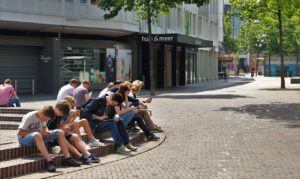 One of the most effective ways for students to get a first-hand feel for college campuses and narrow their perspective college lists is to spend time planning a variety of campus visits. This is also a key way students can show “demonstrated interest” in a college, an aspect that is considered in admissions, especially at smaller or lesser known schools. We thought it would be helpful to look at these trips in detail, both in terms of planning trips strategically and what specifically to do on campus once you get there.
One of the most effective ways for students to get a first-hand feel for college campuses and narrow their perspective college lists is to spend time planning a variety of campus visits. This is also a key way students can show “demonstrated interest” in a college, an aspect that is considered in admissions, especially at smaller or lesser known schools. We thought it would be helpful to look at these trips in detail, both in terms of planning trips strategically and what specifically to do on campus once you get there.
Research the school ahead of time, in part by talking to school counselors, high school alumni and family friends. These are all good resources to gather initial information about a college, and can help students and parents differentiate facts from rumors. An even better way to get the inside scoop on a school is to see if friends or family know any alumni or currently enrolled students. Ideally, they can provide you with details like essential campus destinations, and the pros and cons of their college experiences.
Book the official college tour. Most schools offer a calendar and booking arrangements online, or you can call the admissions office to sign-up for a tour. A guided tour may include perks like a look at the dorms or classrooms, not to mention a sense of the community and selling points from your guide. These may be things you wouldn’t see if you were walking the campus on your own. That said, spending some time in the bookstore or eating a meal at a popular student destination are also great compliments to the official tour. Try to also speak with a few random students about their undergraduate experiences as well, as sometimes, the best details come from unexpected and spontaneous places. 
Inquire about meeting with an admissions officer during your visit. This is an option at many schools, and it’s a great chance to make an in-person impression on the admissions office and get a clearer sense of what the college has to offer. Think of this as an opportunity that can only help your chances of admission, so do your homework and have some questions about the university at the ready. Note: Be sure and dress as if you were going on a job interview—no jeans, gum or sleeveless shirts.
Try and visit a range of schools, but rest assured, there is no need to fly all over the country. We advise creating one or two regional visits if possible, with a plan to see 4-6 colleges in each region. We also recommend visiting campuses that vary in size, class offerings, surrounding environment and community feel. If it is cost prohibitive to travel widely, you can always visit the campuses within driving distance of where you live. Here in the Bay Area, that could mean visiting Stanford, UC Berkeley, UC Santa Cruz, San Jose State, San Francisco State, St. Mary’s and Santa Clara—a fantastic mix of private, public, small, large, urban and suburban schools.
 Use the information you’ve gathered in terms of your college list. In our work with college counseling students, their feedback from campus visits can be one of the most effective tools in developing and refining college lists. Spending ten minutes at the end of each campus experience taking notes and capturing what you liked or didn’t like about a school can be invaluable information. (Pictures help too, as after a few campuses, the details start to blend together!) Beyond your college list, saving and organizing all of this research can be incredibly helpful later on, especially in terms of writing college-specific “why” essays.
Use the information you’ve gathered in terms of your college list. In our work with college counseling students, their feedback from campus visits can be one of the most effective tools in developing and refining college lists. Spending ten minutes at the end of each campus experience taking notes and capturing what you liked or didn’t like about a school can be invaluable information. (Pictures help too, as after a few campuses, the details start to blend together!) Beyond your college list, saving and organizing all of this research can be incredibly helpful later on, especially in terms of writing college-specific “why” essays.
We hope these tips are helpful as you start to think about campus visits this spring or summer. For more information about Green Ivy’s college counseling and academic advising services, click here.
